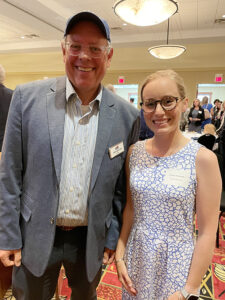By Cathy DeDe, Chronicle Managing Editor

“Today I’ll be largely the bearer of bad news,” Dr. Rachel Sederberg told the Warren County Economic Development Corporation’s annual luncheon last Friday at the Great Escape Lodge.
Dr. Sederberg’s topic was “The Demographic Drought,” or “Bridging the Gap in our Labor Force.”
The research manager with the consulting firm Emsi Burning Glass in Boston brought sobering data to the gathering of business leaders, elected officials and community members.
“It’s not just a perfect storm, it’s a hurricane, earthquake, and tornado all rolled into one,” Dr. Sederberg said.
Low birth rates, slowed immigration, Baby Boomers retiring — these all contribute to what she deems the future labor crisis. “You can’t employ what you don’t have,” she said, “and this train is going to keep coming at us.”
Cut to the conclusion: “Disengaged not unemployed is the problem,” Dr. Sederberg said. Millions of males, ages 16 to 19, are not looking for work. 2.6 million people retired during Covid.
“There are 3.5 million disengaged people, not consciously looking, but on the sidelines. But if the right thing came around, they’d jump.”
She asked,” “How do we reenergize them?”
“We need to go find them. We need to get our message out to the people who are out of the labor force. That’s where the missing worker is.”
Baby boom set the stage
“We need to know where we are, so we can make progress,” Dr. Sederberg said.
Quoting and paraphrasing from her talk:
Baby boomers, who have long exerted “massive power” over the social and economic landscape, were already aging out of the workforce, beginning around 2002 “well before Covid.”
The baby boom saw rising birth rates, a “huge” leap in the number of women in the work force, and increased college enrollment. It drove “massive” and unprecedented gains in household wealth.
“In February 2020 we had record low unemployment. Then our world turned upside down.”
She cited 7 million job openings, with 5.9 people actively looking for work — “and millennials can’t make up for that.”
Also on the decline, since before Covid: the number of prime-age working men.
More people 55 and older were already choosing to work part time, “because they wanted to, they had the savings and they could.”
Where we’re at now
Since Covid: “Labor force participation is not improving. About 3 million people dropped out of the work force, with no intention of returning.”
Almost a million dropped out of the workforce to start their own businesses.
Seven million of today’s 11.4 million job openings are meant for those without a college degree — and those are the ones largely going unfilled, Dr. Sederberg said — “a huge 7 million job problem.”
An epidemic of opioid addiction and overdoses has depleted the youth male work force. More than 100,000 “prime age working men” died of opioid overdoses last year, she said.
Meanwhile, there’s a “birth dearth” — U.S. birth rate is 1.6 children per woman, below “the replenishment rate” of 2.1.
By 2034, “older adults will outnumber children — for the first time ever in this country,” Dr. Sederberg said.
She asks, with dependent children and seniors outnumbering those of working age, who will support them?
Can’t we use robots, she asked?
“Fun fact,” Dr. Sederberg answered herself, even generating a laugh, “To build and run robots requires 12 million more jobs than now.”
Meanwhile, “If you can’t get workers from within, you get them from outside,” which is also not happening. “We are essentially missing 2 million immigrants — 638,000 immigrants in 2021, versus as many as 1,063,000 in pre-Covid years.
Beyond manual labor in agriculture and elsewhere, “Health care relies on foreign workers,” she said.
She said one in four U.S. medical doctors and health aides and one in five nurses are typically foreign born.
A skewed bit of hope: With Covid stimulus payments over, “How are people paying for things if they’re not working?”
Dr. Sederberg said credit card debt is up. Household savings are down. People are selling assets. That’s not sustainable.”
Jim Siplon: ‘Our best days’
“I’m not sure I should say ‘Thank you’,” deadpanned Kathy Muncil, CEO of Fort William Henry, after the talk, to introduce the next speaker.
EDC President Jim Siplon, concluding the luncheon, noted that despite the pandemic, “Last year was the greatest year in our tourism economy — ever.”
He pointed to Stewart’s Shops, Kirsh motorcycle helmets, Brookfield Renewable Energy and Nettle Meadow Cheese, profiled in the first of a planned series of promotional videos. (See adjacent box.)
“They’re the best of us, and they are also showing us the way out,” said Mr. Siplon. “Companies big and small who have not thrown up their hands…”
“Our County figured it out like nobody else and then we told everybody else how to do it. We are already evolving into the next wave. We are in a strategic position, at the top of the Capital District, the cherry on their sundae, and we are also the gateway to the North. We know people want to live here. What will it take to bring them?”
“I watched you all do it better than anyone in the state. For this to become the place you all want it to be…There’s money, and energy out there. We are ready to make this happen.”
Copyright © 2022 Lone Oak Publishing Co., Inc. All Rights Reserved
 Glens Falls Chronicle Serving the Glens Falls/Lake George region; Warren, Washington and northern Saratoga counties since 1980
Glens Falls Chronicle Serving the Glens Falls/Lake George region; Warren, Washington and northern Saratoga counties since 1980

